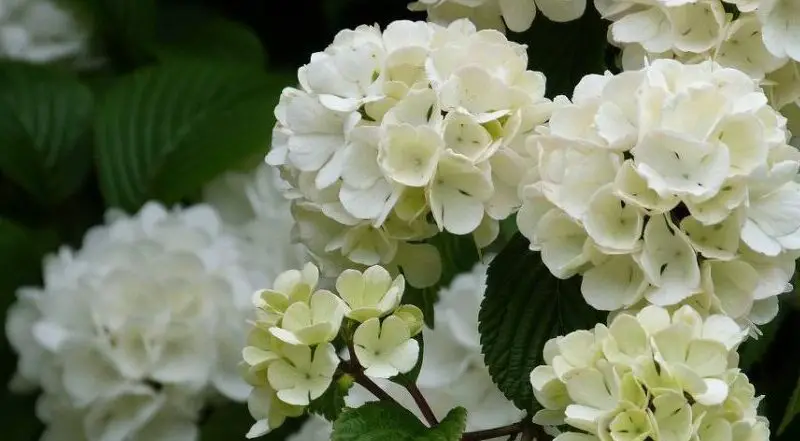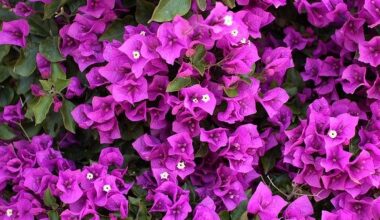The Viburnum opulus, a common shrub in our countryside, likes the sun as well as half-shade. Its flowering in May-June is followed by bright red berries that birds are particularly fond of.
The Viburnum opulus ‘Roseum’ or snowball, sterile version of Viburnum opulus, is certainly the best known cultivar of this species. The obier viorns do wonderfully in an open or country hedge. This shrub, with average growth, easy to live with, is to be preferred when one does not have too much time to devote to the maintenance of a garden.
Contents
Planting of the white flower ball plant (Viburnum)
How to plant the viburnum opulus
No matter which variety is chosen, viburnum does not require a particular soil: a normal, fresh and well-drained soil will do the trick.
The planting of viburnum snowball in the fall is more favorable to a better rooting but nothing prevents to install it in spring. The viburnum likes everywhere as long as it receives a minimum of sunshine. However, it must be avoided to be exposed only to the sun: a semi-shaded area is therefore perfect for it.
When to plant the white flower ball plant (viburnum) ?
Preferably plant it at the beginning of autumn, this is the best time for planting because the slowing down of the vegetation allows the shrub to develop its roots well and to settle well in the garden. It will resume beautifully the following spring.
It is of course possible to plant the viburnum in spring.
Maintenance of the Viburnum Opulus Roseum (White Flower Ball Plant)
We suggest that you mulch the vines to keep the soil cool during the summer. However, Viburnum opulus and Viburnum x burkwoodii tolerate drought rather well. Mulching can also be an additional protection to get through the winter.
Viburnum opulus likes rich soil: it is rather nutrient-demanding. In order to promote their growth, bring fertilizer or compost every year in the spring. Weed, put a few handfuls of slow-release fertilizer or a layer of compost (1 inch) at the base of the shrub and incorporate it by scratching the soil.
Vine worms are susceptible to several diseases and pests. They can be attacked by aphids, weevils and the viburnum’s Chrysomela (Pyrrhalta viburni). Otiorhynchids sometimes consume the leaves. They are also susceptible to black spot and armillary disease. Laurel (Viburnum tinus) is sensitive to whiteflies and Viburnum davidii to phytophthora.
Phytophthora and black spot disease are caused by a fungus. Avoid excess water and bring a layer of gravel or clay beads when planting to facilitate drainage. To keep your Viburnum plants healthy and free from these diseases – especially Viburnum plicatum, which is particularly sensitive to them – it is important to plant them in light, deep, non-calcareous soil!
White flower ball plant pruning
It is not always necessary to trim the horns. You can do it to keep a harmonious shape, and then remove dead or damaged branches. Intervene then in spring, after flowering, on subjects at least three or four years old. Carry out rather light pruning on persistent species.
We suggest that you prune only when necessary, especially if you wish to have fruit in the autumn. Pruning after flowering will limit the appearance of decorative berries. viburnums sometimes emit suckers or suckers that come from the foot: if you see any, remove them.
Viburnum lantana and Viburnum davidii are very well satisfied with a light pruning, which just allows to give them back a balanced shape and to remove some dead or badly positioned branches. As for Viburnum x burkwoodii and Viburnum plicatum, they do not need pruning. Laurel tin can withstand fairly severe pruning, giving it a more elaborate shape and controlling its growth when planted in hedges.
Which plant goes well with the white flower ball plant ?
Plant the viburnum with bulbous spring plants such as tulips and daffodils or other shrubs such as charcoal.
The leaves of my Viburnum are withered
If the leaves of your viburnum have a curled up appearance, this is probably due to black aphids. Inspect the plant for the presence of aphids and ants. Spray a solution of black soap or nettle manure.
There are black larvae on my viburnum, what can I do?
It is certainly the chrysomela of the viburnum (Pyrrhalta viburni). They cut the leaves into lace, leaving only the veins. Observe the leaves carefully: if they are cut in this way, manually remove the larvae and leaves that carry eggs. Spray with a natural pyrethrum-based insecticide or black soap solution.
My white flower ball plant does not grow
After planting, viburnums need time to settle and start growing. Be patient if you have planted it recently. If your viburnum does not grow, it can also be a sign of a lack of nitrogen, phosphorus or potassium. Bring slow-release fertilizer or compost in the spring to promote their growth.
Laurel is one of the slowest growing species. It is perfect for small gardens (especially since it can withstand severe pruning)! Viburnum rhytidophyllum and opulus grow much faster.
My viburnum does not bloom, what can I do?
This may be due to an excess of nutrients and nitrogen-rich fertilizers: they promote vegetative growth to the detriment of flowering. Cut off the food! Also check that the growing conditions are suitable for it.
Too much shade limits flowering. As a reminder, the viburnum appreciates being planted in half-shade or in the sun, in cool and draining soil. Finally, if you obtained your viburnum by sowing, know that you will have to wait several years before seeing it bloom.
Summary
The snowball viburnum or viburnum opulus is a very beautiful shrub, appreciated in our gardens for its beautiful flowering. The planting, the maintenance and the pruning participate largely in the good growth of the snowball viburnum.









